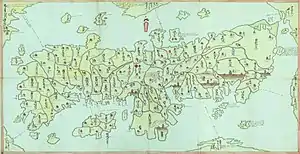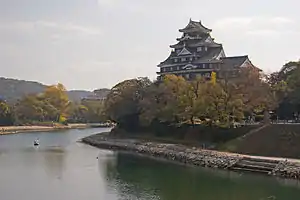Okayama Domain
The Okayama Domain (岡山藩, Okayama han) was a Japanese domain of the Edo period. It was associated with Bizen Province in modern-day Okayama Prefecture.[1]
| Okayama Domain 岡山藩 | |
|---|---|
| Domain of Japan | |
| 1600–1871 | |
| Capital | Okayama Castle |
| • Type | Daimyō |
| Historical era | Edo period |
• Established | 1600 |
• Disestablished | 1871 |
| Today part of | Okayama Prefecture |
In the han system, Okayama was a political and economic abstraction based on periodic cadastral surveys and projected agricultural yields.[2] In other words, the domain was defined in terms of kokudaka, not land area.[3] This was different from the feudalism of the West.
History

Bizen Okayama Ikeda's family crest "Bizen Butterfly"
The domain sided with the Kyoto government during the Boshin War.
List of daimyōs
The hereditary daimyōs were head of the clan and head of the domain.
- Kobayakawa clan, 1600–1602 (tozama; 510,000 koku)[1]
- Ikeda clan, 1603–1632 (tozama/jun-shinpan; 280,000 → 380,000 → 315,000 koku)[4]
- Ikeda clan, 1632–1871 (tozama; 315,000 koku)[1]
Genealogy (simplified; Ikeda clan – Okayama)
- Ikeda Tsuneoki (1536–1584)
- Terumasa, 1st daimyō of Himeji (1565–1613)
- Toshitaka, 2nd daimyō of Himeji (1584–1616)
 I. Mitsumasa, 1st daimyō of Okayama (2nd creation. cr. 1632) (1609–1682; r. 1632–1672)
I. Mitsumasa, 1st daimyō of Okayama (2nd creation. cr. 1632) (1609–1682; r. 1632–1672)
 II. Tsunamasa, 2nd daimyō of Okayama (2nd creation) (1638–1714; r. 1672–1714)
II. Tsunamasa, 2nd daimyō of Okayama (2nd creation) (1638–1714; r. 1672–1714)
 III. Tsugumasa, 3rd daimyō of Okayama (2nd creation) (1702–1776; r. 1714–1752)
III. Tsugumasa, 3rd daimyō of Okayama (2nd creation) (1702–1776; r. 1714–1752)
 IV. Munemasa, 4th daimyō of Okayama (2nd creation) (1727–1764; r. 1752–1764)
IV. Munemasa, 4th daimyō of Okayama (2nd creation) (1727–1764; r. 1752–1764)
 V. Harumasa, 5th daimyō of Okayama (2nd creation) (1750–1819; r. 1764–1794)
V. Harumasa, 5th daimyō of Okayama (2nd creation) (1750–1819; r. 1764–1794)
-
 VI. Narimasa, 6th daimyō of Okayama (2nd creation) (1773–1833; r. 1794–1829)
VI. Narimasa, 6th daimyō of Okayama (2nd creation) (1773–1833; r. 1794–1829)
-
- Sagara Nagahiro, 12th daimyō of Hitoyoshi (1752–1813)
- Sagara Yorinori, 13th daimyō of Hitoyoshi (1774–1856)
- Sagara Yoriyuki, 14th daimyō of Hitoyoshi (1798–1850)
 X. Akimasa, 10th daimyō of Okayama (2nd creation) 1st Marquess (1836–1903; r. 1868–1869, Governor of Okayama: 1869–1871, Marquess: 1884)
X. Akimasa, 10th daimyō of Okayama (2nd creation) 1st Marquess (1836–1903; r. 1868–1869, Governor of Okayama: 1869–1871, Marquess: 1884)
- Norimasa, 13th family head and 2nd Marquess (1865–1909; 11th family head and 2nd Marquess: 1903–1909)
- Tadamasa, 14th family head and 3rd Marquess (1895–1920; 12th family head and 3rd Marquess: 1909–1920).
- Nobumasa, 15th family head and 4th Marquess (1904–1988; 13th family head and 4th Marquess: 1920–1947, 13th family head: 1947–1988)
- Takamasa, 16th family head (1926–2012; 14th family head: 1988–2012). m. Princess Atsuko of the Imperial House of Japan (b. 1931). No issue; the family became extinct after his death.
- Norimasa, 13th family head and 2nd Marquess (1865–1909; 11th family head and 2nd Marquess: 1903–1909)
- Sagara Yoriyuki, 14th daimyō of Hitoyoshi (1798–1850)
- Sagara Yorinori, 13th daimyō of Hitoyoshi (1774–1856)
 I. Tadatsugu, 1st daimyō of Okayama (1st creation. cr. 1603) (1599–1615; r. 1603–1615)
I. Tadatsugu, 1st daimyō of Okayama (1st creation. cr. 1603) (1599–1615; r. 1603–1615) II. Tadakatsu, 2nd daimyō of Okayama (1st creation) (1602–1632; r. 1615–1632)
II. Tadakatsu, 2nd daimyō of Okayama (1st creation) (1602–1632; r. 1615–1632)
 III. Mitsunaka, 3rd daimyō of Okayama (1st creation), 1st daimyō of Tottori (3rd creation) (1630–1693; r. 1632)
III. Mitsunaka, 3rd daimyō of Okayama (1st creation), 1st daimyō of Tottori (3rd creation) (1630–1693; r. 1632)
- Nakazumi, 1st daimyō of Tottori-Shinden (1650–1722)
- Yoshiyasu, 3rd daimyō of Tottori (3rd creation) (1687–1739)
- Muneyasu, 4th daimyō of Tottori (3rd creation) (1717–1747)
- Shigenobu, 5th daimyō of Tottori (3rd creation) (1746–1783)
- Harumichi, 6th daimyō of Tottori (3rd creation) (1768–1798)
- Iyohime Chikako (1792–1824) m. Shimazu Narioki, 10th daimyō of Satsuma (1791–1859)
-
 VII. Naritoshi, 7th daimyō of Okayama (2nd creation) (1811–1842; r. 1829–1842)
VII. Naritoshi, 7th daimyō of Okayama (2nd creation) (1811–1842; r. 1829–1842)
-
- Iyohime Chikako (1792–1824) m. Shimazu Narioki, 10th daimyō of Satsuma (1791–1859)
- Harumichi, 6th daimyō of Tottori (3rd creation) (1768–1798)
- Shigenobu, 5th daimyō of Tottori (3rd creation) (1746–1783)
- Muneyasu, 4th daimyō of Tottori (3rd creation) (1717–1747)
- Yoshiyasu, 3rd daimyō of Tottori (3rd creation) (1687–1739)
- Nakazumi, 1st daimyō of Tottori-Shinden (1650–1722)
- Toshitaka, 2nd daimyō of Himeji (1584–1616)
- Motosuke (1559–1584)
- Yoshiyuki (1577–1618)
- Yoshinari (1605–1676)
- Yoshitaka (1641–1696)
- Yoshimichi (1681–1743)
- Masamichi, 3rd daimyō of Kamogata (1714–1792)
- Masanao, 5th daimyō of Kamogata (1746–1818)
- Masami, 6th daimyō of Kamogata (1772–1819)
- Masayoshi, 8th daimyō of Kamogata (1811–1847)
- Utako (1830–1877) m.
 VIII. Yoshimasa, 8th daimyō of Okayama (2nd creation) (1823–1893; r. 1842–1863. Son of the 5th daimyō of Nakatsu.)
VIII. Yoshimasa, 8th daimyō of Okayama (2nd creation) (1823–1893; r. 1842–1863. Son of the 5th daimyō of Nakatsu.)
- Hisako (1848-1868) m.
 IX. Mochimasa, 9th daimyō of Okayama (2nd creation) (1839–1899; r. 1863–1868. Son of Tokugawa Nariaki, daimyō of Mito.)
IX. Mochimasa, 9th daimyō of Okayama (2nd creation) (1839–1899; r. 1863–1868. Son of Tokugawa Nariaki, daimyō of Mito.)
- Hisako (1848-1868) m.
- Utako (1830–1877) m.
- Masayoshi, 8th daimyō of Kamogata (1811–1847)
- Masami, 6th daimyō of Kamogata (1772–1819)
- Masanao, 5th daimyō of Kamogata (1746–1818)
- Masamichi, 3rd daimyō of Kamogata (1714–1792)
- Yoshimichi (1681–1743)
- Yoshitaka (1641–1696)
- Yoshinari (1605–1676)
- Yoshiyuki (1577–1618)
- Terumasa, 1st daimyō of Himeji (1565–1613)
See also
- List of Han
- Abolition of the han system
References

- "Bizen Province" at JapaneseCastleExplorer.com; retrieved 2013-4-25.
- Mass, Jeffrey P. and William B. Hauser. (1987). The Bakufu in Japanese History, p. 150.
- Elison, George and Bardwell L. Smith (1987). Warlords, Artists, & Commoners: Japan in the Sixteenth Century, p. 18.
- Papinot, Jacques Edmond Joseph. (1906). Dictionnaire d’histoire et de géographie du Japon; Papinot, (2003). "Ikeda" at Nobiliare du Japon, p. 14 [PDF 18 of 80]; retrieved 2013-4-25.
- Genealogy
External links
- "Okayama" at Edo 300 (in Japanese)
This article is issued from Wikipedia. The text is licensed under Creative Commons - Attribution - Sharealike. Additional terms may apply for the media files.

